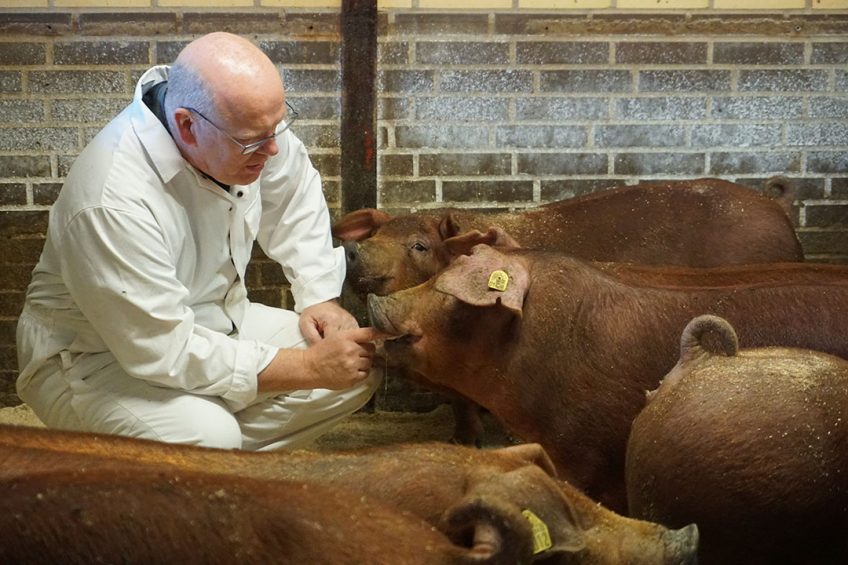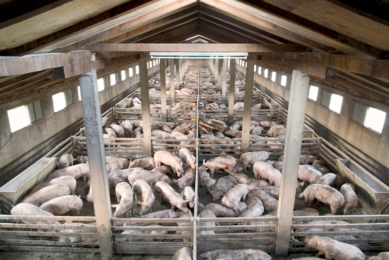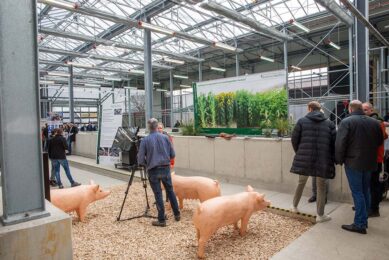Farm visit Denmark: Crossing borders for genetic cooperation

Denmark’s breeding system has been going through a substantial change in recent years. One of the country’s nucleuses, Møllevang, decided to team up with genetics company PIC, offering its owner Niels Pedersen entirely new markets.
ProfileName: Niels Pedersen |
“They always call me Mr Fortunate,” says Niels Pedersen with a big smile. “Everybody says it – and I believe it too, that I’m blessed with great employees, most of whom have been working with me for years. That means that I don’t have to explain a lot to them about the importance of biosecurity, for instance; they understand, and any newcomer will also quickly adjust to the working culture.”
Pedersen is the owner of Møllevang, a proud 2-site Danish nucleus herd with 1,250 sows and a multiplication site with another 1,250 sows near the town of Holsted in Jutland, having pure line Landrace, Yorkshire and Duroc animals. Everything is top-notch here – it is the top of the breeding pyramid in specific-pathogen-free production conditions.
Pedersen, originally from a dairy background, started his career in the pig business as a multiplier farm in 2000. He gradually grew towards becoming a nucleus as he actually enjoyed the paperwork and analysis in addition to the technical stuff in the barn. “Improving pig quality is what I find tremendously interesting; that kept me going.”
Despite all that, a few years ago Pedersen needed some good fortune as he found himself back in a situation that wasn’t optimal for him and especially not good for the genetic improvement of the breeding herd at Møllevang.
The Danish pig industry
In order too understand that situation it’s good to zoom out a little. Up until a few years ago, seen from the perspective of foreign genetics companies, Denmark was a mighty and fairly closed fortress. In a cooperative structure, over 25 Danish nucleuses – Møllevang being one – together formed the well-protected Danish genetics base. Over the years, however, Pedersen came to realise that the cooperative structure was not how he would like to face the future. To cut a long story short: He left the cooperative in mid of 2017, with effect of July 2, 2018. No longer being part of the Danish pig cooperative meant that a great deal of domestic support fell away. Yet income had to be guaranteed and the genetic progress could not come to a standstill. The big question was how to go on from there.

Joint venture with PIC
Having looked around in the world of genetics he eventually decided to join an internationally operating genetics company – in mid-2018 he teamed up with PIC in a strategic partnership. A conversation with Bill Christianson and Matt Culbertson, respectively COO and director of global product development at PIC, convinced him that he had found the right counterparts.
“I just know that I have ended up in the right group of people,” Pedersen says. “When we shook each other’s hand to establish the cooperation, it felt good.”
With the cooperation with PIC, Møllevang became and becomes much stronger and can focus on a more global role.” – Pedersen.
On paper, the cooperation was a win-win situation for both parties, as it allows PIC to market Danish genetic material, and it also allows Pedersen access to a worldwide audience and the opportunity to be more actively involved in the further development of his own genetics.
Pedersen realised he had found his soulmates outside Denmark. For instance, hardly any adjustments were needed with regard to biosecurity, as Møllevang and PIC turned out to be already working along the same lines in many aspects, working with a dirty outside zone and a clean inside zone. Pedersen says, “With the cooperation with PIC, Møllevang became and becomes much stronger and can focus on a more global role.”
He uses a similar phrase about the customer base. Pedersen managed to retain a couple of customers inside Denmark, but explains that the majority of Møllevang’s customers are in other European countries such as Germany, Austria and the Netherlands.

Farm visits
With an interactive map Pig Progress takes you around the world one pig production farm at a time.
Farm structure
Møllevang is built up of 2 farm locations that are about 8km apart:
- One site is the nucleus herd,
- The other a multiplication unit for the breeding of F1 animals.
Nucleus site:
On the nucleus site, which Pedersen calls “the lab”, Møllevang works in 3 large barns with purebred Landrace (now called PIC L04), Yorkshire (PIC L05) and Duroc (PIC 800) lines.
This is where new pure line animals are born and maintained. It’s not economies of scale that count here, he explains, but genetic progress. “For a female you just have more chances to get through than a male,” Pedersen describes the detailed process on the basis of genomic selection and breeding values. In the case of the male pigs, around one in 100 will be used for breeding purposes. All will grow up as boars – once the best specimens have been identified, the rest will eventually be sold for use in sausages, at a lower market value than conventional pigs as they could not be castrated.
Although not too much had to be changed after joining with PIC, there have been a few aspects of the breeding process Pedersen likes to accentuate.
- Something they already used to do was measure the weights of all the piglets. This information in the long run provides an idea about the development of mortality reduction.
- Leg scoring has become an important aspect in the breeding process.
- Counting the number of teats is closely monitored – and if possible enhanced.

Country focus
1 country at the time… Pig Progress looks into production and consumption, exports and imports, even challenges and opportunities.
Quarantine periods for employees
The farm is run by 35 employees from 3 different nationalities, Pedersen explains – from Denmark, Ukraine and Romania. Most have found their way to work in Danish farms, managed to speak Danish and are keen to build up their future in the country too. “We have clear rules – whenever someone has been visiting their home country, they have to be in quarantine in Denmark for 3 days before they can start working on the farm again.”

Win-win situation?
On paper, the cooperation with PIC was a win-win situation. What is the feeling after more than a year working together? Pedersen is clear about that. “I now have a more direct say in what is going to happen with my genetics. I’m still convinced I have made the right decision for the future of the Møllevang genes – and last but not least for me and my family.”
So all in all, a fortunate man he is, in more than one way. Genetic improvement got a boost with the cooperation with the integration into the PIC database. And practically coinciding with Pedersen joining PIC, the market has been helping a little too. Due to African Swine Fever, demand for high quality breeding animals has grown fast.
Understandably, the doors to the pig houses stayed closed for Pig Progress for biosecurity reasons. The pictures from inside the farm were taken by on-site veterinarians with a camera belonging to Møllevang at the instruction of Pig Progress.
PIC and the new geneticsFor PIC, the addition of Møllevang to its team means that the company can provide a different kind of genetic line to its portfolio. Apart from the well-known Camborough sow (a cross of PIC L02 and PIC L03), L04 and L05 are also now available. Pedersen says, “After all, in different parts of the world sometimes there are different requirements as to what kind of animals are needed.” As a consequence of the move to PIC, a lot of Møllevang’s breeding material was also shipped to build additional nucleus and multiplication capacities. That was for two main reasons: to make sure that the increasing demand in other areas could be supplied with local/regional production and to build a robust and reliable supply chain, backed up with sufficient contingency. The two dam lines will continue to exist next to each other. Trials will be carried out to see what improvements in one line can benefit the other. PIC are careful to keep the pure lines of both breeds apart. |


 Farm: Møllevang (Danish for ‘mill yard’) is a swine farm consisting of a 1,250 sow nucleus herd and a 1,250 sow multiplication unit, both near Holsted, Jutland, Denmark. The farm was founded in 2000 and gradually expanded to the current size. In total 35 people from 3 different nationalities work at Møllevang.
Farm: Møllevang (Danish for ‘mill yard’) is a swine farm consisting of a 1,250 sow nucleus herd and a 1,250 sow multiplication unit, both near Holsted, Jutland, Denmark. The farm was founded in 2000 and gradually expanded to the current size. In total 35 people from 3 different nationalities work at Møllevang.













